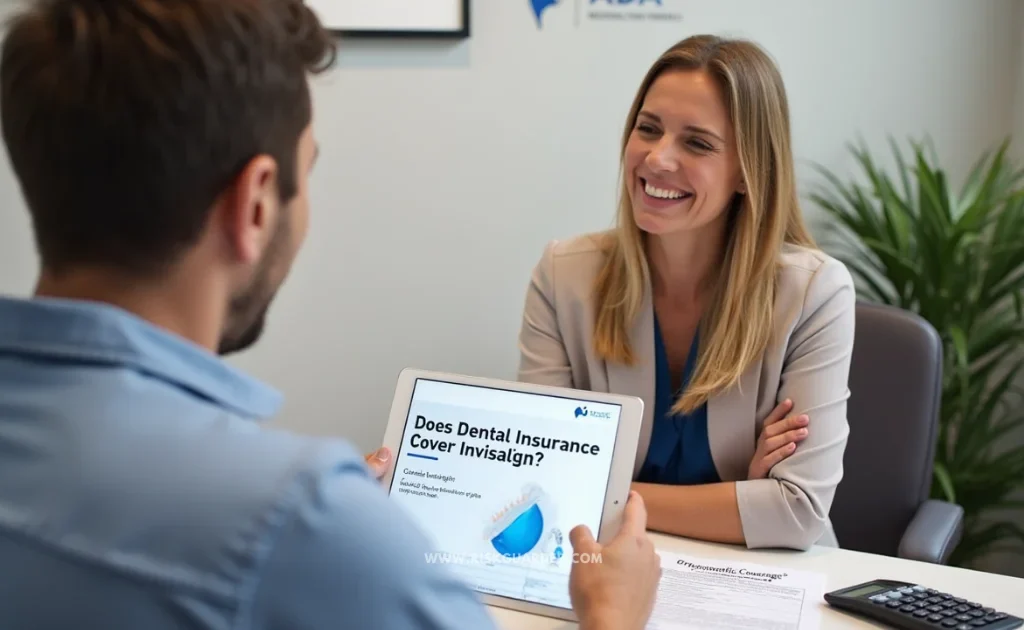The Cost Dilemma of Straightening Your Smile
Imagine this: You’ve finally decided to invest in Invisalign to achieve the smile you’ve always wanted. But as you research, a pressing question arises: Does dental insurance cover Invisalign? The thought of balancing your desire for a confident smile with the reality of costs can be overwhelming. In this guide, we’ll break down everything you need to know about orthodontic coverage, from policy loopholes to hidden savings opportunities, so you can make an informed decision without financial stress.
Orthodontic treatment is a significant investment, and understanding your insurance benefits is crucial. Let’s dive into how you can navigate your policy and maximize coverage for Invisalign.
What Is Invisalign—and How Does Dental Insurance Apply?

Before diving into specifics, let’s clarify what Invisalign is and how dental insurance policies interact with it. Invisalign is a modern orthodontic treatment that uses clear, removable aligners to straighten teeth. Unlike traditional braces, it offers discretion and convenience, making it a popular choice for adults and teens alike.
When it comes to insurance, here’s how coverage typically works:
- Orthodontic Benefits: Many dental plans categorize Invisalign under orthodontic care, which may have separate deductibles and lifetime maximums.
- Policy Language: Some insurers explicitly mention “clear aligners,” while others group them with braces or exclude them entirely.
According to the American Association of Orthodontists (AAO) , Invisalign is now the preferred method for 25% of orthodontic patients. However, coverage varies widely, so understanding your plan’s terms is essential.
Key Factors That Determine Coverage for Invisalign
Whether your dental insurance covers Invisalign depends on several critical factors. Let’s explore each one in detail:

1. Type of Dental Plan
- PPO Plans: Preferred Provider Organizations (PPOs) often offer partial coverage for Invisalign, especially if deemed medically necessary.
- HMO Plans: Health Maintenance Organizations (HMOs) typically restrict coverage to basic preventive care, excluding cosmetic treatments like Invisalign.
- Discount Plans: These aren’t insurance but may reduce costs by 10-20% if your dentist participates.
2. Orthodontic Benefits Clause
- Coverage Details: Some plans explicitly exclude Invisalign, while others classify it as a covered orthodontic appliance.
- Lifetime Maximums: Most plans cap orthodontic benefits at $1,500-$3,000, which may only partially cover Invisalign’s total cost.
- Waiting Periods: Newly enrolled members may need to wait 6-12 months before accessing orthodontic benefits.
3. Provider Network Restrictions
- In-Network Savings: Using a dentist within your insurer’s network often results in higher reimbursement rates.
- Out-of-Network Costs: You may still receive partial coverage, but your out-of-pocket expenses will likely increase.
4. Medical Necessity
- Documentation: Insurers often require proof from your orthodontist that Invisalign addresses functional issues (e.g., bite misalignment) rather than purely cosmetic concerns.
- Age Limitations: Some plans only cover orthodontic treatments for minors, excluding adults.
Steps to Check If Your Dental Insurance Covers Invisalign
Navigating your policy doesn’t have to be confusing. Follow these steps to determine your coverage:

- Review Your Policy’s Summary of Benefits:
Look for sections on orthodontic care. Check if “clear aligners” or “Invisalign” are explicitly mentioned. - Contact Your Insurer Directly:
Ask questions like:- “Does my plan cover Invisalign?”
- “Is there a waiting period for orthodontic treatments?”
- “What percentage of the cost is reimbursed?”
- Consult Your Orthodontist:
They can help document medical necessity and submit a predetermination request to your insurer. - Calculate Out-of-Pocket Costs:
Subtract your deductible and estimated reimbursement from the total treatment cost to understand your financial responsibility.
Pro Tip: Use your insurer’s online portal to track coverage details and claims status in real-time.
Average Costs of Invisalign and Insurance Contributions
Invisalign treatment typically costs between $3,000 and $8,000 , depending on complexity and location. Here’s how insurance might contribute:
| Plan Type | Coverage Percentage | Annual Maximum | Typical Reimbursement |
|---|---|---|---|
| PPO (Comprehensive) | 20%-50% | $1,500-$3,000 | $500-$2,500 |
| HMO (Basic) | 0% | N/A | $0 |
| Discount Plan | N/A | N/A | 10%-20% off total cost |
(Note: Coverage varies by plan and provider.)
For example, if your PPO covers 50% up to $3,000, you’d receive $1,500 toward a $5,000 treatment, leaving you to pay $3,500.
Alternatives if Your Dental Insurance Doesn’t Cover Invisalign
If your plan excludes Invisalign, don’t lose hope. Here are practical ways to manage costs:
- Payment Plans: Many orthodontists offer interest-free financing over 12-24 months.
- Health Savings Accounts (HSAs): Use pre-tax dollars to pay for treatment if your plan qualifies.
- Discount Programs: Some dental chains or membership clubs provide reduced rates for aligners.
- Shop Around: Compare prices from multiple providers; costs can vary by thousands of dollars.
Pro Tip: Combine multiple strategies (e.g., HSA + payment plan) to minimize upfront expenses.
Common Misconceptions About Invisalign Coverage
Misunderstandings about insurance coverage can lead to costly surprises. Let’s debunk a few myths:
- Myth #1: “All dental insurance covers Invisalign.”
Reality: Many plans exclude clear aligners unless explicitly stated. - Myth #2: “Coverage is the same for adults and children.”
Reality: Some insurers limit orthodontic benefits to minors, leaving adults to pay more. - Myth #3: “Invisalign is purely cosmetic.”
Reality: It can correct functional issues like overbites or overcrowding, qualifying for coverage.
By addressing these myths, you can approach your insurance provider with clarity and confidence.
FAQs About Does Dental Insurance Cover Invisalign
Let’s tackle some frequently asked questions to clear up lingering doubts:
Q1: Does dental insurance cover Invisalign for adults?
Coverage varies. Some plans cover adults if treatment is medically necessary, while others exclude them entirely.
Q2: What if my insurance denies coverage?
Appeal the decision with documentation from your orthodontist or explore alternative payment options.
Q3: Can I use multiple insurance plans for Invisalign?
Yes, if you have dual coverage (e.g., through a spouse’s plan). Coordinate benefits to maximize reimbursement.
Q4: How long does insurance approval take?
Typically 2-4 weeks after submitting a predetermination request and supporting documents.
Conclusion: Navigating Invisalign Coverage with Confidence
The answer to does dental insurance cover Invisalign depends on your plan’s terms, your dentist’s network status, and the medical necessity of your treatment. While coverage isn’t guaranteed, understanding these factors empowers you to advocate for yourself and explore creative solutions to manage costs. With the right strategy, achieving a straighter smile doesn’t have to break the bank.
CTA:
Ready to take the next step? Schedule a consultation with an orthodontist and review your insurance policy today. Share your thoughts or questions in the comments below—we’d love to help!






